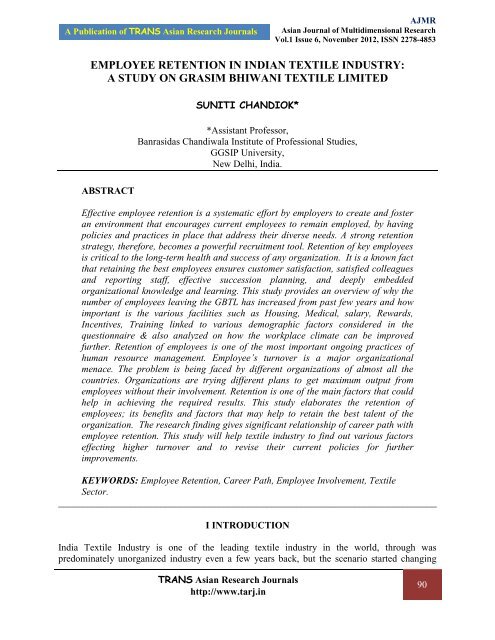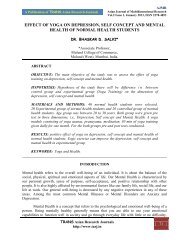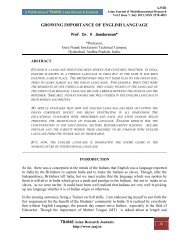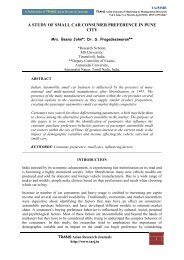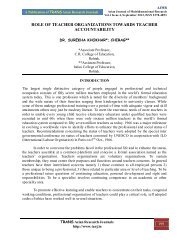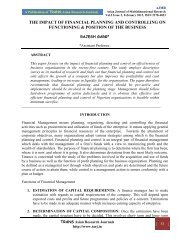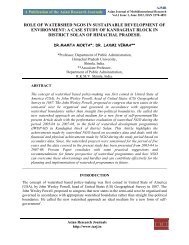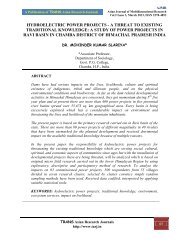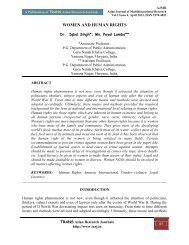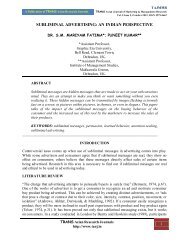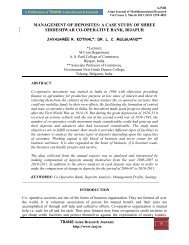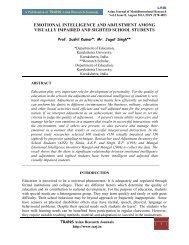11.10 Suniti Chandiok.pdf - tarj.in
11.10 Suniti Chandiok.pdf - tarj.in
11.10 Suniti Chandiok.pdf - tarj.in
You also want an ePaper? Increase the reach of your titles
YUMPU automatically turns print PDFs into web optimized ePapers that Google loves.
A Publication of TRANS Asian Research Journals<br />
AJMR<br />
Asian Journal of Multidimensional Research<br />
Vol.1 Issue 6, November 2012, ISSN 2278-4853<br />
EMPLOYEE RETENTION IN INDIAN TEXTILE INDUSTRY:<br />
A STUDY ON GRASIM BHIWANI TEXTILE LIMITED<br />
SUNITI CHANDIOK*<br />
*Assistant Professor,<br />
Banrasidas Chandiwala Institute of Professional Studies,<br />
GGSIP University,<br />
New Delhi, India.<br />
ABSTRACT<br />
Effective employee retention is a systematic effort by employers to create and foster<br />
an environment that encourages current employees to rema<strong>in</strong> employed, by hav<strong>in</strong>g<br />
policies and practices <strong>in</strong> place that address their diverse needs. A strong retention<br />
strategy, therefore, becomes a powerful recruitment tool. Retention of key employees<br />
is critical to the long-term health and success of any organization. It is a known fact<br />
that reta<strong>in</strong><strong>in</strong>g the best employees ensures customer satisfaction, satisfied colleagues<br />
and report<strong>in</strong>g staff, effective succession plann<strong>in</strong>g, and deeply embedded<br />
organizational knowledge and learn<strong>in</strong>g. This study provides an overview of why the<br />
number of employees leav<strong>in</strong>g the GBTL has <strong>in</strong>creased from past few years and how<br />
important is the various facilities such as Hous<strong>in</strong>g, Medical, salary, Rewards,<br />
Incentives, Tra<strong>in</strong><strong>in</strong>g l<strong>in</strong>ked to various demographic factors considered <strong>in</strong> the<br />
questionnaire & also analyzed on how the workplace climate can be improved<br />
further. Retention of employees is one of the most important ongo<strong>in</strong>g practices of<br />
human resource management. Employee’s turnover is a major organizational<br />
menace. The problem is be<strong>in</strong>g faced by different organizations of almost all the<br />
countries. Organizations are try<strong>in</strong>g different plans to get maximum output from<br />
employees without their <strong>in</strong>volvement. Retention is one of the ma<strong>in</strong> factors that could<br />
help <strong>in</strong> achiev<strong>in</strong>g the required results. This study elaborates the retention of<br />
employees; its benefits and factors that may help to reta<strong>in</strong> the best talent of the<br />
organization. The research f<strong>in</strong>d<strong>in</strong>g gives significant relationship of career path with<br />
employee retention. This study will help textile <strong>in</strong>dustry to f<strong>in</strong>d out various factors<br />
effect<strong>in</strong>g higher turnover and to revise their current policies for further<br />
improvements.<br />
KEYWORDS: Employee Retention, Career Path, Employee Involvement, Textile<br />
Sector.<br />
______________________________________________________________________________<br />
I INTRODUCTION<br />
India Textile Industry is one of the lead<strong>in</strong>g textile <strong>in</strong>dustry <strong>in</strong> the world, through was<br />
predom<strong>in</strong>ately unorganized <strong>in</strong>dustry even a few years back, but the scenario started chang<strong>in</strong>g<br />
TRANS Asian Research Journals<br />
http://www.<strong>tarj</strong>.<strong>in</strong><br />
90
A Publication of TRANS Asian Research Journals<br />
AJMR<br />
Asian Journal of Multidimensional Research<br />
Vol.1 Issue 6, November 2012, ISSN 2278-4853<br />
after the economic liberalization <strong>in</strong> India economy <strong>in</strong> 1991.The open<strong>in</strong>g up of economy gave the<br />
much needed trust to the Indian textile <strong>in</strong>dustry, which how successfully become one of the<br />
largest <strong>in</strong> the world. Indian textile <strong>in</strong>dustry largely depends upon the textile manufactur<strong>in</strong>g and<br />
export. It also plays a major role <strong>in</strong> the economy of the country. India earns about 27% of its<br />
total foreign exchange through textile export further, the textile <strong>in</strong>dustry of India also contributes<br />
nearly 14% of the total Industrial production of the country. It also contributes around 3% to the<br />
GDP of the country.<br />
Indian textile <strong>in</strong>dustry is also the largest <strong>in</strong> the country <strong>in</strong> terms of employment generation. It not<br />
generates jobs <strong>in</strong> its own <strong>in</strong>dustry, but also opens up scopes for the other ancillary sectors. Indian<br />
textile <strong>in</strong>dustry currently generates employment to more then 35 million people. The Indian<br />
textile <strong>in</strong>dustry contributes about 14% of <strong>in</strong>dustrial production,4% to country’s gross domestic<br />
product(GDP) and 17% to country’s exports earn<strong>in</strong>gs. The <strong>in</strong>dustry provides direct employment<br />
to over 35 million people and is the second largest provider of employment after agriculture.<br />
Fibric production rose to 60,996 million sq meters <strong>in</strong> FY 2011 from 52,665 million sq meters <strong>in</strong><br />
FY 2007.Production o raw cotton grew to 32.5 million bales <strong>in</strong> FY 2011 from 28 million bales<br />
FY 2007 while production of man-made fabric rose to 1281 million kgs <strong>in</strong> FY 2011 from 1139<br />
million kgs <strong>in</strong> FY 2007. Production of yarn grew to 6,233 million kgs <strong>in</strong> FY 2011 from 5,183<br />
million kgs <strong>in</strong> FY 2007.India has potential to <strong>in</strong>crease its textile and apparel world tread from the<br />
current level of 4.5% to 8% and reach US$ 80 billion by 2020.Export of textile grew to USD<br />
26.8 billion <strong>in</strong> FY 2010 from USD 17.6 billion <strong>in</strong> FY 2006.India’s textile trade is dom<strong>in</strong>ated by<br />
exports with a CAGR of 6.3% dur<strong>in</strong>g the same period.<br />
INDUSTRY PROFILE<br />
Grasim has a strong presence <strong>in</strong> fabrics and synthetic yarns through its subsidiary, Grasim<br />
Bhiwani Textiles Limited (GBTL), and is well known for its branded suit<strong>in</strong>gs, Grasim and<br />
Graviera, ma<strong>in</strong>ly <strong>in</strong> the polyester - cellulosic branded menswear. Its textile plants are located at<br />
Bhiwani (Haryana) and Malanpur (Madhya Pradesh). Fabric operations are centralized at<br />
Bhiwani with a process<strong>in</strong>g capacity of 17.0 million metres a year. Vikram Woollens, Malanpur, a<br />
unit of Grasim manufactures worsted dyed yarn spun from 100 per cent mer<strong>in</strong>o wool along with<br />
polyester and other blends.Grasim's strong nationwide retail network <strong>in</strong>cludes exclusive<br />
showrooms, wholesalers and multi-brand outlets through which it reaches its customers. Grasim<br />
caters to <strong>in</strong>ternational fashion houses <strong>in</strong> the USA and UK supply<strong>in</strong>g fabric to them for<br />
manufactur<strong>in</strong>g of garments, which are available <strong>in</strong> some of the largest retail cha<strong>in</strong> stores.Grasim<br />
was <strong>in</strong>corporated on 25 August 1947, exactly 10 days after India achieved <strong>in</strong>dependence. Grasim<br />
is more than an Industrial enterprise. It is the symbol of INDIA’S surge for economic and<br />
<strong>in</strong>dustrial liberation. Grasim is world largest producer of viscos staple fiber and edible oil and<br />
textile production. The organization bhiwani textile mills are a unit of Grasim Industrial Ltd. Its<br />
Head Office is at nagda (m.p) and work<strong>in</strong>g office at Bhiwani. This mill is under dynamic<br />
leadership of Mr. Kumar Mangalam Birla<br />
EMPLOYEE RETENTION<br />
Employee retention is an important ongo<strong>in</strong>g process <strong>in</strong> which the organization reta<strong>in</strong>s the<br />
employees for the maximum period of time or until the completion of the project. It is a<br />
TRANS Asian Research Journals<br />
http://www.<strong>tarj</strong>.<strong>in</strong><br />
91
A Publication of TRANS Asian Research Journals<br />
AJMR<br />
Asian Journal of Multidimensional Research<br />
Vol.1 Issue 6, November 2012, ISSN 2278-4853<br />
cont<strong>in</strong>u<strong>in</strong>g employment relationship. Today, organizations f<strong>in</strong>d out that balance of power which<br />
has shifted from the employer to employees. Excessive turnover is a sign of fundamental<br />
problems with<strong>in</strong> the bus<strong>in</strong>esses and it is very important to know that how to reta<strong>in</strong> employees <strong>in</strong><br />
the particular organization. Today textile <strong>in</strong>dustry is fac<strong>in</strong>g few problems regard<strong>in</strong>g power<br />
supplies and major of all is the yarn prices. But this is a fact that they don’t give proper salaries<br />
and rewards to laborers. Role of human resource practices is very crucial <strong>in</strong> this regard. Human<br />
resource practices can only be applicable to the learn<strong>in</strong>g organizations. Employees can be<br />
reta<strong>in</strong>ed and satisfied with<strong>in</strong> those organizations which keep on learn<strong>in</strong>g that how to keep their<br />
employee’s satisfaction at highest level. Apart from this, there is no proper work <strong>in</strong> the textile<br />
<strong>in</strong>dustry <strong>in</strong> the field of human resource management, because top management never realizes the<br />
needs and demands of their employees. There are very few textile mills that are practic<strong>in</strong>g the<br />
human resource management <strong>in</strong> its fullest and they are gett<strong>in</strong>g maximum benefits from it. To<br />
develop a better understand<strong>in</strong>g of this issue, a research has been carried out to know the benefits<br />
of the human resource practices employed by these mills and to implement them <strong>in</strong> other<br />
organizations for positive results. To keep employees and keep their satisfaction levels high, any<br />
organization needs to implement each of the three R’s of employee retention: respect,<br />
recognition, and rewards.<br />
II LITERATURE REVIEW<br />
In developed and emerg<strong>in</strong>g countries, Attraction and retention of employees is of the most<br />
desired practice and competence of the high performance organizations. Search for best talent<br />
will be very difficult <strong>in</strong> com<strong>in</strong>g years. Retention can be possible by many ways but one of the<br />
most used <strong>in</strong> organizations is pay<strong>in</strong>g more than they are earn<strong>in</strong>g. Hansen (2002) argued that pay<br />
more to the employees <strong>in</strong> order to achieve better f<strong>in</strong>ancial position and reta<strong>in</strong> those employees<br />
who lead from the front to atta<strong>in</strong> bus<strong>in</strong>ess goals. Short and long term <strong>in</strong>centives should be given<br />
accord<strong>in</strong>g to the goals of bus<strong>in</strong>ess that will help to have more organized and strong management<br />
team for long term results. Lawler III (2005) stated that <strong>in</strong> these days organizations are<br />
compet<strong>in</strong>g for talent rather than count<strong>in</strong>g employees loyalty. They are focus<strong>in</strong>g on attract<strong>in</strong>g,<br />
hir<strong>in</strong>g and reta<strong>in</strong><strong>in</strong>g the required talented persons. For this purpose organizations must utilize<br />
those practices which are <strong>in</strong> favor of both employees and employers lead<strong>in</strong>g them towards higher<br />
performance levels. It is important to recruit strategy driven and shrewd employees because it<br />
creates sense of alignment between employee and organizational values and goals. Gentry et al.,<br />
(2007) argued that employees feel connected with the organization if they get support from their<br />
supervisors which lead them to return the favor to the supervisors and organization through<br />
retention.<br />
Cotton et al., (1988) Employee’s participation <strong>in</strong> decision has found some positive effects on the<br />
performance of employees. Participation <strong>in</strong> work related matters effects performance more<br />
positively rather than <strong>in</strong> determ<strong>in</strong><strong>in</strong>g the pay practices. Pierce et al., (1991) said ownership has<br />
some direct and <strong>in</strong>dependent effects over groups and <strong>in</strong>dividual behaviors and attitudes that lead<br />
towards effective performance. To participate <strong>in</strong> the organization matters is the formal “right” of<br />
the employees just like stockholders. They can <strong>in</strong>fluence the decisions of organization like the<br />
election of board of directors. This ownership has positive relationship with organizational<br />
performance. Romzek (1989) expla<strong>in</strong>ed that employees hav<strong>in</strong>g higher <strong>in</strong>volvement <strong>in</strong> their work<br />
and organization have better relations with their families and social environment which creates a<br />
TRANS Asian Research Journals<br />
http://www.<strong>tarj</strong>.<strong>in</strong><br />
92
A Publication of TRANS Asian Research Journals<br />
AJMR<br />
Asian Journal of Multidimensional Research<br />
Vol.1 Issue 6, November 2012, ISSN 2278-4853<br />
psychological attachment with the organization. Rousseau (1990) described that relationship<br />
between employee and employer starts from the recruitment, foster<strong>in</strong>g the long term relationship<br />
and loyalty while some organizations emphasize on rewards and performance of the employees.<br />
Friedman (2006) and Hacker (2004) expla<strong>in</strong>ed that new comers <strong>in</strong> the organization didn’t take<br />
much time to decide whether to proceed with the current organization or quit to and f<strong>in</strong>d some<br />
other workplace and this decision normally is made <strong>in</strong> few days or week after appo<strong>in</strong>tment.<br />
Vos & Meganck (2009) <strong>in</strong>dicated that career development plan for the employees play a vital<br />
role <strong>in</strong> the retention of employees. Provid<strong>in</strong>g these career development opportunities restrict<br />
employees from leav<strong>in</strong>g the organization and <strong>in</strong>crease <strong>in</strong> loyalty. Hiltrop (1999) suggested that<br />
prepare and develop plans to get best talent as successful organizations are work<strong>in</strong>g on this to<br />
avoid future deficit of the required competent employees because there is always room for the<br />
improvement <strong>in</strong> recruitment process. It is also suggested that companies must adjust their desires<br />
and necessities accord<strong>in</strong>g to the market situation so that retention of employees can be made<br />
possible. Hannay & Northan (2000) argued that future opportunities for the employees also help<br />
<strong>in</strong> reta<strong>in</strong><strong>in</strong>g employees because these opportunities are associated with more pay, additional<br />
work responsibilities, superior work environment and different <strong>in</strong>centives plans. Money is not<br />
sole factor but it has significant effect while recruit<strong>in</strong>g the employee.<br />
Social network<strong>in</strong>g among employees is also vital to reta<strong>in</strong> employees because whenever<br />
employee left job, the whole relationship between worker and supervisor and among all workers<br />
is changed. Chapman (2009) expla<strong>in</strong>ed that it is the responsibility of senior employees to help<br />
new employees to familiarize and socialize with the environment of the organization and make<br />
them best fit for the organization. Guthrie. (2000) identified that pay<strong>in</strong>g employees accord<strong>in</strong>g to<br />
their knowledge and skills is a traditional approach so that pay is attached to the performance.<br />
Profit shar<strong>in</strong>g is also a source by which employees are rewarded but this only happens when<br />
organizations achieve their profit marg<strong>in</strong>s set by themselves. It is found that skill based pay helps<br />
to reduce the turnover. Along with few other factors may also reduce the turnover rate of the<br />
organizations as Oldham & Brass (1979) suggested that physical environment of the work place<br />
effects a lot to the performance quality of the employees because satisfaction and motivation<br />
with peers and works decl<strong>in</strong>ed after chang<strong>in</strong>g the work place environment. Employee benefits<br />
provision (2010) Proper communication of employee benefits, their scope and impact is good<br />
and successful opportunity for the organization to reta<strong>in</strong> employees and then try to know what<br />
are they expect<strong>in</strong>g and want from organization.<br />
III OBJECTIVES OF THE STUDY<br />
• To create a better work<strong>in</strong>g environment for employees through effective HR practices.<br />
• Cost reduction is one of the basic functions of the HR department which can be atta<strong>in</strong>ed by<br />
select<strong>in</strong>g “Right person for the right job <strong>in</strong> GBTL.<br />
• To understand and ga<strong>in</strong> monetary benefits for the employees with the effective use of HR<br />
practices.<br />
• Creat<strong>in</strong>g better atmosphere where employees can perform their duties <strong>in</strong> GBTL.<br />
TRANS Asian Research Journals<br />
http://www.<strong>tarj</strong>.<strong>in</strong><br />
93
A Publication of TRANS Asian Research Journals<br />
AJMR<br />
Asian Journal of Multidimensional Research<br />
Vol.1 Issue 6, November 2012, ISSN 2278-4853<br />
• To give a proper career path to the employee.<br />
RESEARCH MODEL<br />
Merit Based Compensation<br />
Work<strong>in</strong>g Environment<br />
Employee Retention<br />
Career Path<br />
NEED OF STUDY<br />
‣ Attrition rate of Grasim Bhiwani Textile Limited has <strong>in</strong>creased <strong>in</strong> last years. This year the<br />
attrition rate is near about 17% as compared to previous year’s 11%. This study would try to<br />
<strong>in</strong>vestigate the possible reasons beh<strong>in</strong>d this.<br />
‣ In spite of giv<strong>in</strong>g so many facilities to its employees, Grasim Bhiwani Textile Limited is not able<br />
to reta<strong>in</strong> 100% of its employees with itself. This study would try to answer the reasons beh<strong>in</strong>d<br />
this.<br />
‣ Grasim Bhiwani Textile Limited conducts an exit <strong>in</strong>terview of employees who are leav<strong>in</strong>g the<br />
organization, but it doesn’t get any big compla<strong>in</strong>t or constructive suggestion from such<br />
<strong>in</strong>terviews also. This study would try to analyze & suggest required changes <strong>in</strong> the exit <strong>in</strong>terview<br />
process & the <strong>in</strong>struments <strong>in</strong>volved <strong>in</strong> that.<br />
RESEARCH PROBLEM<br />
‣ Why the number of employees not reta<strong>in</strong><strong>in</strong>g <strong>in</strong> Grasim Bhiwani Textile Limited<br />
SWOT ANALYSIS OF GRASIM BHIWANI TEXTILE LIMITED<br />
STRENGTH : BTM is a composite firm <strong>in</strong> Haryana and BTM is a f<strong>in</strong>ancially sound firm. Their work<strong>in</strong>g<br />
environment is very peaceful (Union is strength and pr<strong>in</strong>ciple is followed by everyone).All the<br />
Facilities are given to employees &employers on time and up to date. The product quality is<br />
given equal to all (wholesalers and retailers).<br />
WEAKNESS: The basic salary structure is not up to date some manipulations are needed and no<br />
sufficient facilities are given to employees and employer<br />
OPPORTUNITIES: Given chance to Grasim to make & sale its product provid<strong>in</strong>g them<br />
manpower, mach<strong>in</strong>e, money, market, material and <strong>in</strong> near future they will start readymade<br />
garments.<br />
TRANS Asian Research Journals<br />
http://www.<strong>tarj</strong>.<strong>in</strong><br />
94
A Publication of TRANS Asian Research Journals<br />
AJMR<br />
Asian Journal of Multidimensional Research<br />
Vol.1 Issue 6, November 2012, ISSN 2278-4853<br />
THREATS: In BTM face threats from its competitors like Vimal, OCM, Siyaram, Raymond.BTM<br />
face threats <strong>in</strong> overseas market live Philipp<strong>in</strong>es, Malaysia, Canada, Mexicoand America.They<br />
have very poor distribution networks.<br />
IV HYPOTHESIS OF STUDY<br />
There is a positive correlation between Human Resource Management Practices and Employee’s<br />
Retention.<br />
H 1; Merit based compensation is positively correlated to Employee’s Retention.<br />
H 2; Work<strong>in</strong>g environment is positively correlated to Employee’s Retention.<br />
H 3; Career Path positively is correlated to Employee’s Retention.<br />
V RESEARCH METHODOLOGY<br />
Sample of the study is the employees work<strong>in</strong>g <strong>in</strong> the Grasim Bhiwani Textile Limited . The<br />
questionnaire tool is used for data collection. It conta<strong>in</strong>s questions that are related to the<br />
demographic <strong>in</strong>formation of the respondent and 40 questions relat<strong>in</strong>g to the variables mentioned<br />
<strong>in</strong> the research model. There are three Independent variable; 1.Merit based compensation<br />
2.Work<strong>in</strong>g Environment. 3. Performance Appraisal Dependant variable is Employee Retention.<br />
Each variable conta<strong>in</strong>s 8 questions. Seven po<strong>in</strong>t likert scales is used to get the exact answer<br />
aga<strong>in</strong>st each question. Those po<strong>in</strong>ts are; 1= strongly disagree, 2= Disagree, 3= Somewhat<br />
Disagree 4= Indifferent, 5=Somewhat Agree, 6= Agree and 7= Strongly Agree. In this first after<br />
prelim<strong>in</strong>ary research, title of the research was f<strong>in</strong>alized. After f<strong>in</strong>aliz<strong>in</strong>g, <strong>in</strong>formation was<br />
collected <strong>in</strong> the context of the title and selected the required <strong>in</strong>formation about the background<br />
history of the country regard<strong>in</strong>g textile <strong>in</strong>dustry. Formulation of the research model was done<br />
along with the dependant and <strong>in</strong>dependent variables. Data was collected from the various<br />
research journals and other publication. Variables and hypothesis were made so that the results<br />
of the research can be drawn. Research objectives were made and questionnaire was developed<br />
for the data collection from the employees work<strong>in</strong>g <strong>in</strong> the textile sector. We received<br />
questionnaires from the respondents after 15 days. Then data entry process was started <strong>in</strong>to the<br />
specified software to apply prescribed tests to get the results and analyze them. Report writ<strong>in</strong>g<br />
was done <strong>in</strong> this period of time. All the data and <strong>in</strong>formation was available, collected and<br />
f<strong>in</strong>alized <strong>in</strong> the form of report.<br />
VI DATA ANALYSIS AND FINDING<br />
Frequencies and descriptive analysis is used to analysis the ma<strong>in</strong> characteristics of the sample.<br />
Besides this Regression Analysis, Reliability and the Pearson Correlation, test was used to check<br />
the validity of the hypotheses.<br />
FINDINGS OF STUDY : The demographic factors deal with the personal profile of the<br />
respondents taken for survey. Gender, age, qualification, work experiences are dealt with <strong>in</strong> the<br />
study. The <strong>in</strong>formation about these factors is important and can be used for data analysis part.All<br />
discussed variables have positive correlation with employee retention. Career path has strong<br />
TRANS Asian Research Journals<br />
http://www.<strong>tarj</strong>.<strong>in</strong><br />
95
A Publication of TRANS Asian Research Journals<br />
AJMR<br />
Asian Journal of Multidimensional Research<br />
Vol.1 Issue 6, November 2012, ISSN 2278-4853<br />
positive correlation r = 0.60, mean = 5.00 with employee retention and H2 is accepted because p<br />
value = 0.00 which must be >0.05 to accept hypothesis. H1 accepted as Compensation correlates<br />
positively with Employee Retention r = 0.55, p value = 0.00, mean = 4.31. Work<strong>in</strong>g<br />
Environment correlates with retention positively but not as much strong like Career Path. H3<br />
accepted as p value = 0.00 with r = 0.48 between work<strong>in</strong>g environment and employee retention.<br />
TABLE: 1 DESCRIPTIVE STATISTICS<br />
ER COM CP WC<br />
Mean 5.00 4.31 5.00 4.96<br />
Median 5.00 4.37 5.18 5.13<br />
Mode 5.00 4.38 5.50 5.12<br />
Std. Deviation 0.80 1.38 1.01 0.95<br />
Range 3.88 5.38 4.75 4.01<br />
M<strong>in</strong>imum 2.50 1.24 1.88 2.63<br />
Maximum 6.38 6.75 6.63 6.62<br />
Sum 598 517 599 595<br />
TABLE-2 CORRELATION<br />
ER COM CP WC P Value<br />
Employees Retention(ER) 1.00<br />
Compensation(COM) 0.55 1.00 0.00<br />
Career Path(CP) 0.60 0.60 1.00 0.00<br />
Work<strong>in</strong>g Condition/Environment(WC) 0.48 0.56 0.60 1.00 0.00<br />
TRANS Asian Research Journals<br />
http://www.<strong>tarj</strong>.<strong>in</strong><br />
96
A Publication of TRANS Asian Research Journals<br />
AJMR<br />
Asian Journal of Multidimensional Research<br />
Vol.1 Issue 6, November 2012, ISSN 2278-4853<br />
TABLE-3:OVERALL DATA ANALYSIS OF RESPONDENTS<br />
S.No Variables SA A UD DA SD result<br />
1. The performance appraisal system prevent <strong>in</strong><br />
the organization is quite effective.<br />
2 31 10 23 4 A<br />
2. Level of tra<strong>in</strong><strong>in</strong>g <strong>in</strong> organization is adequate. 1 19 19 25 6 DA<br />
3. Our organization goes out of its way to make<br />
sure that employees enjoy their work as well<br />
as their life.<br />
4. Weakness of employees is communicated to<br />
them <strong>in</strong> a non threaten<strong>in</strong>g way.<br />
5. My superiors give me feedback on regular<br />
basis on my performance.<br />
6. I feel that I shall be able to cont<strong>in</strong>ue & grow<br />
with this organization.<br />
7. I have full freedom to experiment with new<br />
ideas <strong>in</strong> my company<br />
8. I would not like to change from this<br />
organization only for the sake of higher<br />
remuneration<br />
9. Employees <strong>in</strong> our organization are encouraged<br />
to take <strong>in</strong>itiative & do th<strong>in</strong>gs their own.<br />
10. I feel that the growth prospect <strong>in</strong> this<br />
organization is slow.<br />
11. I feel that the exist<strong>in</strong>g system of grant<strong>in</strong>g<br />
<strong>in</strong>crement is quite effective.<br />
12. Employee’s return<strong>in</strong>g from tra<strong>in</strong><strong>in</strong>g programs<br />
are given opportunities to try out what they<br />
have learnt.<br />
13. My relationship with members of my work<br />
group is friendly as well as professional.<br />
2 18 17 31 2 DA<br />
3 28 17 18 4 A<br />
5 25 15 21 4 A<br />
6 34 17 9 4 A<br />
9 34 7 16 4 A<br />
5 25 15 21 4 A<br />
0 32 16 22 0 A<br />
3 56 9 2 0 A<br />
1 19 19 25 6 DA<br />
7 36 6 18 3 A<br />
18 48 2 1 1 A<br />
14. In our organization job rotation is used as an 4 25 12 23 6 A<br />
TRANS Asian Research Journals<br />
http://www.<strong>tarj</strong>.<strong>in</strong><br />
97
A Publication of TRANS Asian Research Journals<br />
AJMR<br />
Asian Journal of Multidimensional Research<br />
Vol.1 Issue 6, November 2012, ISSN 2278-4853<br />
important tool of employee development<br />
15. There is lot of conflict between<br />
department/divisions.<br />
2 32 6 15 5 A<br />
16. Employees are not asked for their suggestions 1 8 8 45 4 DA<br />
17. Proper recognition is given to people giv<strong>in</strong>g<br />
extra ord<strong>in</strong>ary performances.<br />
7 44 8 8 3 A<br />
18. My job is not challeng<strong>in</strong>g. 3 14 10 36 7 DA<br />
19. Employees <strong>in</strong> our organization are helpful to<br />
each other<br />
3 56 9 2 0 A<br />
The above overall the questionner analysis shows that the level of tra<strong>in</strong><strong>in</strong>g <strong>in</strong> the organization is<br />
not much effective, the <strong>in</strong>crement system <strong>in</strong> the organization is not effective, employees are not<br />
asked of their suggestions, remuneration system is not effective, employees feel that the growth<br />
prospects are slow, and there is lot of conflicts between departments. The compensation,<br />
<strong>in</strong>crements, benefits are very much important for an employee to live a healthy life. But the<br />
employee’s response shows that the compensation is not good at GBTL. There is lot of conflicts<br />
between departments and employees are not asked of their suggestions, this shows that the<br />
work<strong>in</strong>g environment is also not good. These are the reasons why the employees are not<br />
reta<strong>in</strong><strong>in</strong>g <strong>in</strong> GBTL. The recommendations are given to improve the work<strong>in</strong>g environment, career<br />
path, and compensation so that employees reta<strong>in</strong> <strong>in</strong> the organization and work for the growth of<br />
the organization.<br />
RESULT AND CONCLUSIONS<br />
The retention of employees has been shown to be significant to the development and the<br />
accomplishment of the organization’s goals and objectives. Retention of employees can be a vital<br />
source of competitive advantage for any organization. Today, changes <strong>in</strong> technology, global<br />
economics, trade agreements, and the like are directly affect<strong>in</strong>g employee/employer<br />
relationships. “Until recently, loyalty was the cornerstone of that relationship. All companies of<br />
any size are struggl<strong>in</strong>g <strong>in</strong> these days that how they could reta<strong>in</strong> their employees from leav<strong>in</strong>g<br />
exist<strong>in</strong>g jobs for more money or for the better opportunity. It is observed that those employees<br />
who left their organizations for more pay, when asked to tell the reasons why they quit, they rate<br />
pay at fifth or sixth place <strong>in</strong> their priorities. The lead<strong>in</strong>g reasons are culture, recognition,<br />
environment, policies of the organization and the relationship with company and co-workers. So<br />
for those organizations who are struggl<strong>in</strong>g of reta<strong>in</strong><strong>in</strong>g employees they must understand the<br />
requirements of the employees and the factors discussed above. This could help them <strong>in</strong> reta<strong>in</strong><strong>in</strong>g<br />
their best talent with them for their long run success. In this study we discussed the<br />
compensation, career path and work<strong>in</strong>g environment effect<strong>in</strong>g retention of the employees. We<br />
TRANS Asian Research Journals<br />
http://www.<strong>tarj</strong>.<strong>in</strong><br />
98
A Publication of TRANS Asian Research Journals<br />
AJMR<br />
Asian Journal of Multidimensional Research<br />
Vol.1 Issue 6, November 2012, ISSN 2278-4853<br />
conclude that career path is most valuable factor that employees look for, to work <strong>in</strong> the<br />
organization<br />
EMPLOYEES PERCEPTION ABOUT THE FACILITIES BEING PROVIDED TO<br />
THEM AT GRASIM BHIWANI TEXTILE LIMITED: The Salary & Incentives given to the<br />
employees <strong>in</strong> Grasim Bhiwani Textile Limited are presumed to be very good by them. Hous<strong>in</strong>g<br />
& medical facilities are also presumed to be good but not excellent. While other facilities like<br />
tra<strong>in</strong><strong>in</strong>g, loans etc. are presumed differently by employees due to which it doesn’t gives any clear<br />
picture as already discussed before, these facilities can be divided <strong>in</strong>to four groups accord<strong>in</strong>g to<br />
their <strong>in</strong>fluence & satisfaction they provided to the respondents.<br />
EMPLOYEES’ WORK PLACE CLIMATE<br />
• Strong areas:<br />
enjoyment of work life by the employee’s<br />
regular feedback on performance<br />
performance appraisal system<br />
healthy relationship among employees,<br />
Growth aspect of employees.<br />
• Weak areas:<br />
Level of tra<strong>in</strong><strong>in</strong>g,<br />
communication of weaknesses to employees,<br />
motivat<strong>in</strong>g employees,<br />
job rotation,<br />
opportunity,<br />
conflict between departments,<br />
Tak<strong>in</strong>g employees’ suggestion.<br />
Low remuneration<br />
All companies of any size are struggl<strong>in</strong>g <strong>in</strong> these days that how they could reta<strong>in</strong> their employees<br />
from leav<strong>in</strong>g exist<strong>in</strong>g jobs for more money or for the better opportunity. It is observed that those<br />
employees who left their organizations for more pay, when asked to tell the reasons why they<br />
quit, they rate pay at fifth or sixth place <strong>in</strong> their priorities. The lead<strong>in</strong>g reasons are culture,<br />
TRANS Asian Research Journals<br />
http://www.<strong>tarj</strong>.<strong>in</strong><br />
99
A Publication of TRANS Asian Research Journals<br />
AJMR<br />
Asian Journal of Multidimensional Research<br />
Vol.1 Issue 6, November 2012, ISSN 2278-4853<br />
recognition, environment, policies of the organization and the relationship with company and coworkers.<br />
So for those organizations who are struggl<strong>in</strong>g of reta<strong>in</strong><strong>in</strong>g employees they must<br />
understand the requirements of the employees and the factors discussed above. This could help<br />
them <strong>in</strong> reta<strong>in</strong><strong>in</strong>g their best talent with them for their long run success. In this study we discussed<br />
the compensation, career path and work<strong>in</strong>g environment effect<strong>in</strong>g retention of the employees.<br />
We conclude that career path is most valuable factor that employees look for, to work <strong>in</strong> the<br />
organization. This study helps organizations to understand the value of their employees and<br />
reasons to reta<strong>in</strong> them because greater turnover means that employees are us<strong>in</strong>g organizations as<br />
a stone to step further and experience they are ga<strong>in</strong><strong>in</strong>g with them is important. To reta<strong>in</strong><br />
employees, the organizations must review their career plans and reorganize those plans<br />
accord<strong>in</strong>g to the market so that <strong>in</strong>telligent and talented employees could serve more and would<br />
beneficial <strong>in</strong> the long run.<br />
REFERENCES<br />
Chapman, C. (2009), Retention beg<strong>in</strong>s before day one: orientation and socialization <strong>in</strong> libraries,<br />
New Library World, Vol.110, No.3/4, pp. 122-135.<br />
Cotton, L. John., Vollarth, A. David., Froggatt, L. Kirk., Lengnick-Hall, L. Mark., Jenn<strong>in</strong>gs, R.<br />
Kenneth. (1988), Employee Participation: Forms and Different Outcomes, Academy of<br />
Management Review, Vol. 13, No. 1, pp 8-22.<br />
Employee benefits provision: Can it impact on talent retention, motivation and productivity<br />
levels?, Human Resource Management <strong>in</strong>ternational Digest, VOL.18, NO.3, pp.10-12, Friedman,<br />
L. (2006), Are you los<strong>in</strong>g potential new hires at hello?, Tra<strong>in</strong><strong>in</strong>g and Development, Vol. 60,<br />
No.11, pp. 7-25.<br />
Gentry, A. William., Kuhnert, W. Karl., Mondore, P. Scott. (2007), The <strong>in</strong>fluence of<br />
supervisory-support climate and unemployment rate on part-time employee retention A<br />
multilevel analysis, Journal of Management Development, Vol.26, No.10, pp. 1005-1022<br />
Guthrie, P. James. (2000), Alternative Pay Practices and Employee Turnover: An Organization<br />
Economics Perspective, Group & Organization Management, Vol.25, No.4, pp 419-439.<br />
Hacker, C.A. (2004), New employee orientation: make it pay dividends for years to come,<br />
Information Systems Management, Vol. 21 No. 1, pp. 89-92.<br />
Hansen, F. (2002), Currents <strong>in</strong> Compensation and Benefits, Compensation & Benefits Review,<br />
Vol.34, No.7, pp 7-21.<br />
Hannay, M. & Northan, M. (2000), Low-Cost Strategies for Employee Retention, Compensation<br />
& Benefits Review, Vol.32, No.65, pp 65-72.<br />
Hiltrop, Jean-Marie. (1999), Human Resource Practices to Attract and Reta<strong>in</strong> Talent, European<br />
Management Journal, Vol.17, No.4, pp. 422–430.<br />
TRANS Asian Research Journals<br />
http://www.<strong>tarj</strong>.<strong>in</strong><br />
100
A Publication of TRANS Asian Research Journals<br />
AJMR<br />
Asian Journal of Multidimensional Research<br />
Vol.1 Issue 6, November 2012, ISSN 2278-4853<br />
Lawler III E. Edward. (2005), Creat<strong>in</strong>g high performance organizations, Asia Pacific Journal of<br />
Human Resources, Vol.43, No.10. pp. 10-17.<br />
Oldham, R. Greg & Brass, J. Daniel. (1979), Employee Reactions to an Open-Plan Office: A<br />
Naturally Occurr<strong>in</strong>g Quasi-Experiment, Adm<strong>in</strong>istrative Science Quarterly, Vol.24, No.2, pp.<br />
267-284.<br />
Pierce. L, Jon., Rubenfeld. A, Stephen., Morgan, S. (1991), Employee Ownership: A Conceptual<br />
Model of process Effects, Academy of Management Review, Vol.16, No.1, pp 121-144.<br />
Romzek, S. Barbara (1989), Personal Consequences of Employee Commitment, The Academy<br />
of Management Journal, Vol.32, No.3, pp. 649-661.<br />
Rousseau, M. Denise. (1990), New hire perceptions of their own and their employer's<br />
obligations: A study of psychological contracts, Journal of Organizational Behavior, Vol.11, pp<br />
389-400.<br />
Vos, D. Ans., & Meganck, A.(2009), What HR managers do versus what employees value<br />
Explor<strong>in</strong>g both parties’ views on retention management from a psychological contract<br />
perspective, Personnel Review, Vol.38, No.1, pp. 45-60.<br />
TRANS Asian Research Journals<br />
http://www.<strong>tarj</strong>.<strong>in</strong><br />
101


